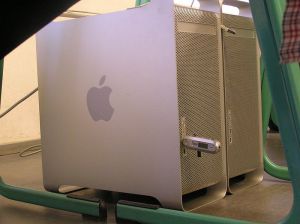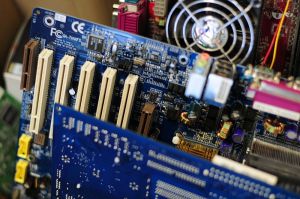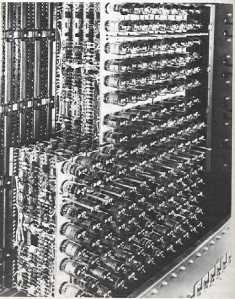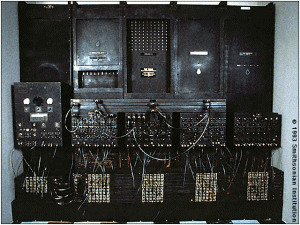HISTORY & GENERATION OF COMPUTER
HISTORY OF COMPUTERS :
The history of computer science began long before the modern discipline of computer science that emerged in the twentieth century, and hinted at in the centuries prior. The progression, from mechanical inventions and mathematical theories towards the modern concepts and machines, formed a major academic field and the basis of a massive worldwide industry.
Early computation
Main articles: History of computing and Timeline of computing 2400 BC–1949
The earliest known tool for use in computation was the abacus, developed in period 2700–2300 BC in Sumer. The Sumerians’ abacus consisted of a table of successive columns which delimited the successive orders of magnitude of their sexagesimal number system. Its original style of usage was by lines drawn in sand with pebbles. Abaci of a more modern design are still used as calculation tools today.
The Antikythera mechanism is believed to be the earliest known mechanical analog computer. It was designed to calculate astronomical positions. It was discovered in 1901 in the Antikythera wreck off the Greek island of Antikythera, between Kythera and Crete, and has been dated to circa 100 BC. Technological artifacts of similar complexity did not reappear until the 14th century, when mechanical astronomical clocks appeared in Europe.
In the 3rd century CE the South Pointing Chariot was invented in ancient China. It was the first known geared mechanism to use a differential gear, which was later used in analog computers. The Chinese also invented a more sophisticated abacus from around the 2nd century BCE, known as the suanpan.
Mechanical analog computing devices appeared a thousand years later in the medieval Islamic world. Examples of devices from this period include the equatorium by Arzachel, the mechanical geared astrolabe by Abū Rayhān al-Bīrūnī, and the torquetum by Jabir ibn Aflah. Muslim engineers built a number of automata, including some musical automata that could be ‘programmed’ to play different musical patterns. These devices were developed by the Banū Mūsā brothers[9] and Al-Jazari Muslim mathematicians also made important advances in cryptography, such as the development of cryptanalysis and frequency analysis by Alkindus.
When John Napier discovered logarithms for computational purposes in the early 17th century, there followed a period of considerable progress by inventors and scientists in making calculating tools. In 1623 Wilhelm Schickard designed a calculating machine, but abandoned the project, when the prototype he had started building was destroyed by a fire in 1624. Around 1640, Blaise Pascal, a leading French mathematician, constructed the first mechanical adding device based on a design described by Greek mathematician Hero of Alexandria. Then in 1672 Gottfried Wilhelm Leibniz invented the Stepped Reckoner which he completed in 1694.
None of the early computational devices were really computers in the modern sense, and it took considerable advancement in mathematics and theory before the first modern computers could be designed.
Binary Logic
In 1703, Gottfried Leibnitz developed logic in a formal, mathematical sense with his writings on the binary numeral system. In his system, the ones and zeros also represent true and false values or on and off states. But it took more than a century before George Boole published his Boolean algebra in 1854 with a complete system that allowed computational processes to be mathematically modeled.
By this time, the first mechanical devices driven by a binary pattern had been invented. The industrial revolution had driven forward the mechanization of many tasks, and this included weaving. Punched cards controlled Joseph Marie Jacquard’s loom in 1801, where a hole punched in the card indicated a binary one and an unpunched spot indicated a binary zero. Jacquard’s loom was far from being a computer, but it did illustrate that machines could be driven by binary systems.
ustrate that machines could be driven by binary systems.
Birth of computer science
Before the 1920s, computers (sometimes computors) were human clerks that performed computations. They were usually under the lead of a physicist. Many thousands of computers were employed in commerce, government, and research establishments. Most of these computers were women, and they were known to have a degree in calculus. Some performed astronomical calculations for calendars.
After the 1920s, the expression computing machine referred to any machine that performed the work of a human computer, especially those in accordance with effective methods of the Church-Turing thesis. The thesis states that a mathematical method is effective if it could be set out as a list of instructions able to be followed by a human clerk with paper and pencil, for as long as necessary, and without ingenuity or insigh t.
t.
Machines that computed with continuous values became known as the analog kind. They used machinery that represented continuous numeric quantities, like the angle of a shaft rotation or difference in electrical potential.
Digital machinery, in contrast to analog, were able to render a state of a numeric value and store each individual digit. Digital machinery used difference engines or relays before the invention of faster memory devices.
The phrase computing machine gradually gave away, after the late 1940s, to just computer as the onset of electronic digital machinery became common. These computers were able to perform the calculations that were performed by the previous human clerks.
Since the values stored by digital machines were not bound to physical properties like analog devices, a logical computer, based on digital equipment, was able to do anything that could be described “purely mechanical.” The theoretical Turing Machine, created by Alan Turing, is a hypothetical device theorized in order to study the properties of such hardware.
GENERATION OF COMPUTERS :
First Generation (1940-1956) Vacuum Tubes
The first computers used vacuum tubes for circuitry and magnetic drums for memory, and were often enormous, taking up entire rooms. They were very expensive to operate and in addition to using a great deal of electricity, generated a lot of heat, which was often the cause of malfunctions.
First generation computers relied on machine language, the lowest-level programming language understood by computers, to perform operations, and they could only solve one problem at a time. Input was based on punched cards and paper tape, and output was displayed on printouts.
The UNIVAC and ENIAC computers are examples of first-generation computing devices. The UNIVAC was the first commercial computer delivered to a business client, the U.S. Census Bureau in 1951
.
Second Generation (1956-1963) Transistors
Transistors replaced vacuum tubes and ushered in the second generation of computers. The transistor was invented in 1947 but did not see widespread use in computers until the late 1950s. The transistor was far superior to the vacuum tube, allowing computers to become smaller, faster, cheaper, more energy-efficient and more reliable than their first-generation predecessors. Though the transistor still generated a great deal of heat that subjected the computer to damage, it was a vast improvement over the vacuum tube. Second-generation computers still relied on punched cards for input and printouts for output.
Second-generation computers moved from cryptic binary machine language to symbolic, or assembly, languages, which allowed programmers to specify instructions in words. High-level programming languages were also being developed at this time, such as early versions of COBOL and FORTRAN. These were also the first computers that stored their instructions in their memory, which moved from a magnetic drum to magnetic core technology.
The first computers of this generation were developed for the atomic energy industry.
Third Generation (1964-1971) Integrated Circuits
The development of the integrated circuit was the hallmark of the third generation of computers. Transistors were miniaturized and placed on silicon chips, called semiconductors, which drastically increased the speed and efficiency of computers.
Instead of punched cards and printouts, users interacted with third generation computers through keyboards and monitors and interfaced with an operating system, which allowed the device to run many different applications at one time with a central program that monitored the memory. Computers for the first time became accessible to a mass audience because they were smaller and cheaper than their predecessors.
Fourth Generation (1971-Present) Microprocessors
The microprocessor brought the fourth generation of computers, as thousands of integrated circuits were built onto a single silicon chip. What in the first generation filled an entire room could now fit in the palm of the hand. The Intel 4004 chip, developed in 1971, located all the components of the computer—from the central processing unit and memory to input/output controls—on a single chip.
In 1981 IBM introduced its first computer for the home user, and in 1984 Apple introduced the Macintosh. Microprocessors also moved out of the realm of desktop computers and into many areas of life as more and more everyday products began to use microprocessors.
As these small computers became more powerful, they could be linked together to form networks, which eventually led to the development of the Internet. Fourth generation computers also saw the development of GUIs, the mouse and handheld devices.
Fifth Generation (Present and Beyond) Artificial Intelligence
Fifth generation computing devices, based on artificial intelligence, are still in development, though there are some applications, such as voice recognition, that are being used today. The use of parallel processing and superconductors is helping to make artificial intelligence a reality. Quantum computation and molecular and nanotechnology will radically change the face of computers in years to come. The goal of fifth-generation computing is to develop devices that respond to natural language input and are capable of learning and self-organization.














